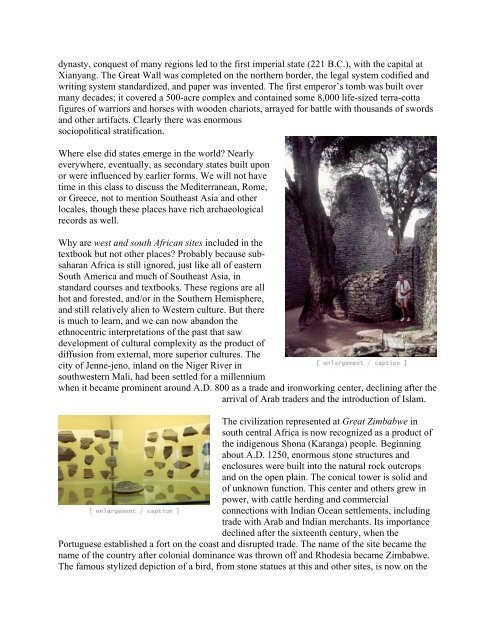INTRODUCTION TO ARCHAEOLOGY Nancy White - Touro Institute
INTRODUCTION TO ARCHAEOLOGY Nancy White - Touro Institute
INTRODUCTION TO ARCHAEOLOGY Nancy White - Touro Institute
You also want an ePaper? Increase the reach of your titles
YUMPU automatically turns print PDFs into web optimized ePapers that Google loves.
dynasty, conquest of many regions led to the first imperial state (221 B.C.), with the capital at<br />
Xianyang. The Great Wall was completed on the northern border, the legal system codified and<br />
writing system standardized, and paper was invented. The first emperor’s tomb was built over<br />
many decades; it covered a 500-acre complex and contained some 8,000 life-sized terra-cotta<br />
figures of warriors and horses with wooden chariots, arrayed for battle with thousands of swords<br />
and other artifacts. Clearly there was enormous<br />
sociopolitical stratification.<br />
Where else did states emerge in the world? Nearly<br />
everywhere, eventually, as secondary states built upon<br />
or were influenced by earlier forms. We will not have<br />
time in this class to discuss the Mediterranean, Rome,<br />
or Greece, not to mention Southeast Asia and other<br />
locales, though these places have rich archaeological<br />
records as well.<br />
Why are west and south African sites included in the<br />
textbook but not other places? Probably because subsaharan<br />
Africa is still ignored, just like all of eastern<br />
South America and much of Southeast Asia, in<br />
standard courses and textbooks. These regions are all<br />
hot and forested, and/or in the Southern Hemisphere,<br />
and still relatively alien to Western culture. But there<br />
is much to learn, and we can now abandon the<br />
ethnocentric interpretations of the past that saw<br />
development of cultural complexity as the product of<br />
diffusion from external, more superior cultures. The<br />
city of Jenne-jeno, inland on the Niger River in<br />
southwestern Mali, had been settled for a millennium<br />
when it became prominent around A.D. 800 as a trade and ironworking center, declining after the<br />
arrival of Arab traders and the introduction of Islam.<br />
The civilization represented at Great Zimbabwe in<br />
south central Africa is now recognized as a product of<br />
the indigenous Shona (Karanga) people. Beginning<br />
about A.D. 1250, enormous stone structures and<br />
enclosures were built into the natural rock outcrops<br />
and on the open plain. The conical tower is solid and<br />
of unknown function. This center and others grew in<br />
power, with cattle herding and commercial<br />
connections with Indian Ocean settlements, including<br />
trade with Arab and Indian merchants. Its importance<br />
declined after the sixteenth century, when the<br />
Portuguese established a fort on the coast and disrupted trade. The name of the site became the<br />
name of the country after colonial dominance was thrown off and Rhodesia became Zimbabwe.<br />
The famous stylized depiction of a bird, from stone statues at this and other sites, is now on the
















